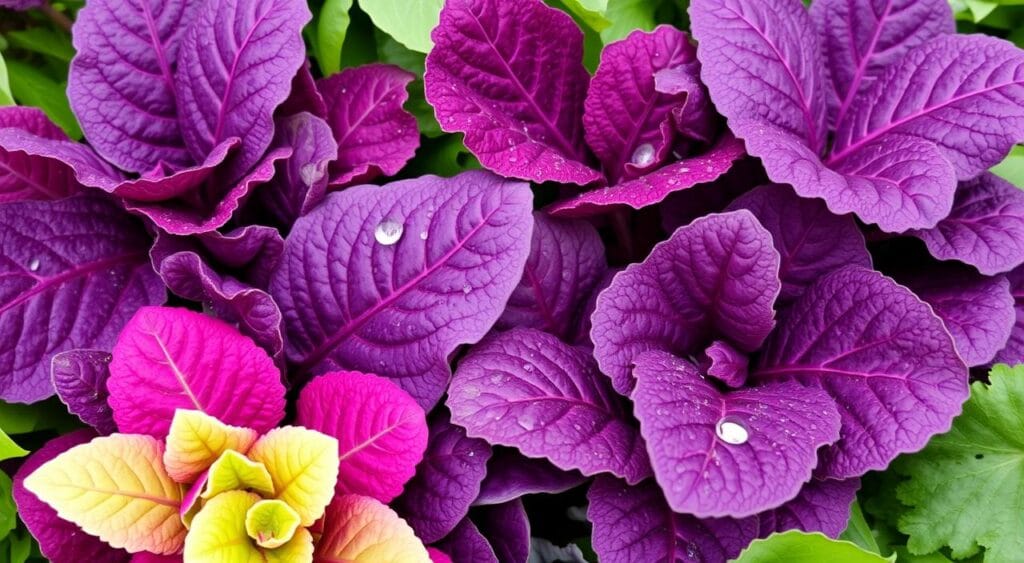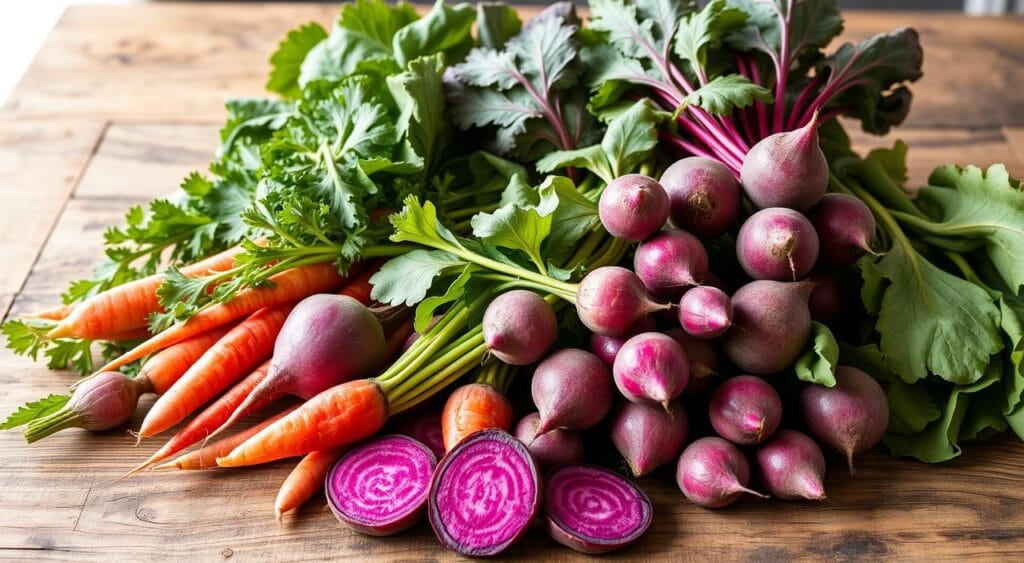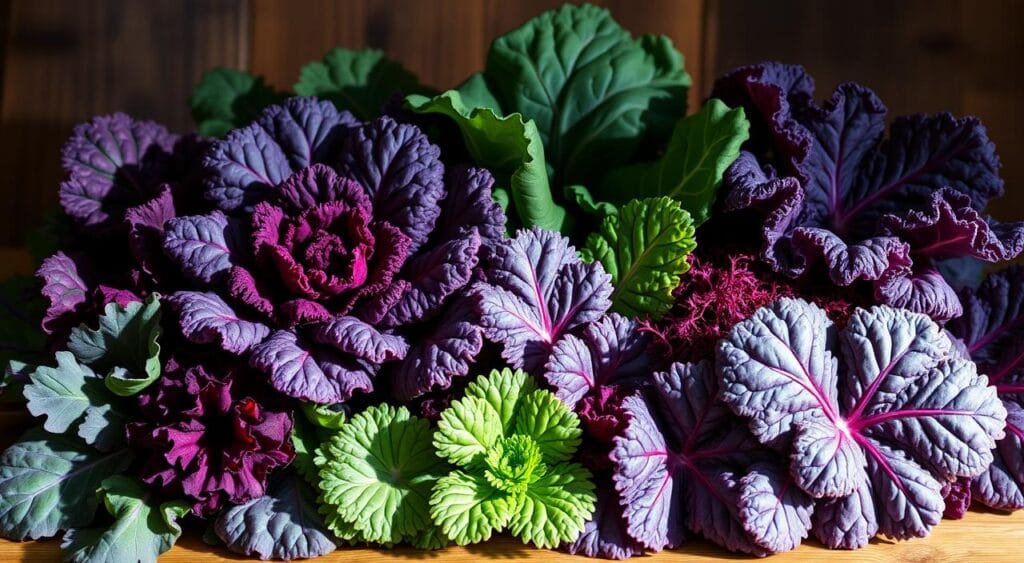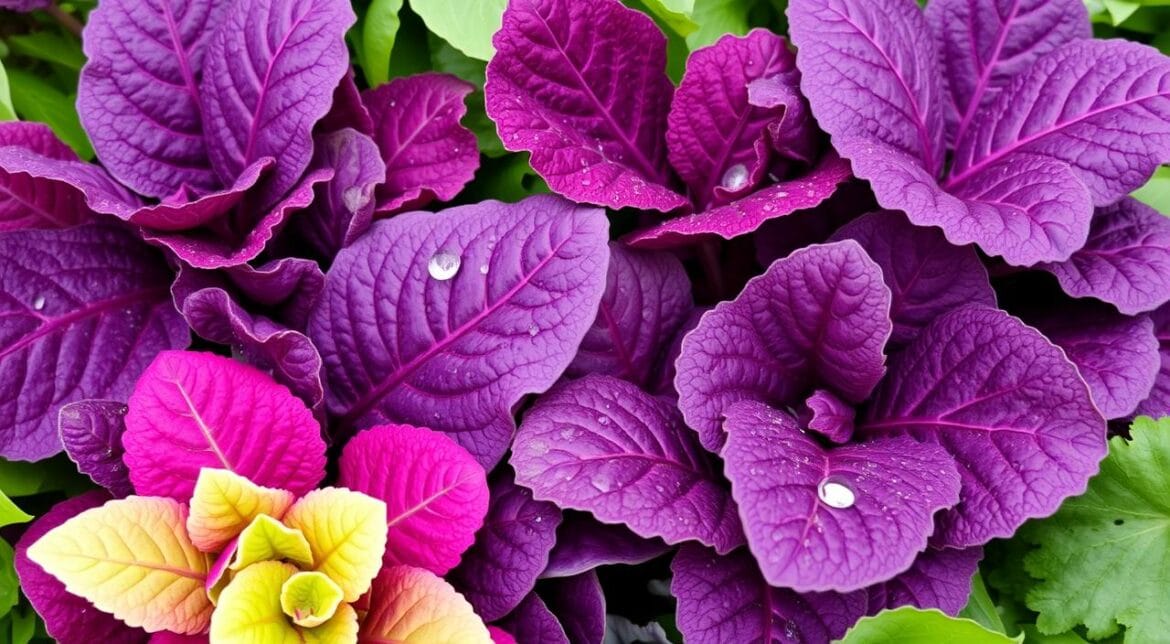Table of Contents
Get ready for a fun food journey into the world of purple leaf vegetables. These colorful veggies are not just pretty to look at. They also pack a nutritional punch that’s great for your health. From their long history to their growing popularity, purple veggies are changing how we eat healthy.

Purple fruits and vegetables are special because of their unique look and health benefits. Their deep color comes from anthocyanins, which are antioxidants. These antioxidants help keep you healthy. As you learn more about purple vegetables, you’ll find they add flavor, variety, and health benefits to your meals.
Key Takeaways
- Explore the diverse world of purple leaf vegetables and their captivating visual appeal.
- Discover the nutritional powerhouse that lies within these vibrant plants, from antioxidants to anti-inflammatory benefits.
- Learn about the rich history and cultural significance of purple vegetables across different regions.
- Gain insights into the science behind the purple pigmentation and its health-promoting properties.
- Uncover practical tips for incorporating these versatile veggies into your daily diet.
Understanding Purple Leaf Vegetables and Their Origins
Purple vegetables have long fascinated chefs and food lovers. They add color and offer health benefits. These purple root vegetables and purple fruits and vegetables come from diverse cultures and places, each with its own tale.
Historical Background of Purple Vegetables
Purple vegetables have been around for thousands of years. They were valued for their healing powers and symbolic meanings. For example, the Incas in South America grew purple potatoes, seen as sacred.
The purple eggplant has been a key ingredient in Asian cooking for ages. Its history in China goes back to the 5th century.
Common Varieties in Modern Agriculture
- Purple Carrots: A vibrant and nutritious twist on the classic orange carrot, purple carrots are making a comeback in modern agriculture, offering a unique flavor profile and a striking visual appeal.
- Red Cabbage: This versatile purple root vegetable is a common sight in many kitchens, known for its bold color, crunchy texture, and diverse culinary applications.
- Purple Potatoes: Descending from their Andean ancestors, modern purple potatoes have become increasingly popular, boasting a creamy texture and a rich, earthy flavor.
Cultural Significance Across Different Regions
Purple vegetables mean more than just food in many cultures. In China, they’re seen as cooling and detoxifying. In Europe, purple cauliflower is a rare and prized find.

| Vegetable | Origin | Cultural Significance |
|---|---|---|
| Purple Potatoes | Andes, South America | Held sacred and ceremonial importance in Inca culture |
| Eggplant | Asia | Cultivated in China since the 5th century, featured in traditional Asian cuisines |
| Purple Cauliflower | Europe | Considered a delicacy in certain regions due to its rarity |
The Science Behind Purple Pigmentation in Vegetables
The vibrant purple colors in some vegetables are not just for show. They come from a cool scientific process. The pigments behind these colors are called anthocyanins. They are part of a bigger group called flavonoids.
Anthocyanins are water-soluble pigments that help protect purple vegetables from harm. They guard against UV radiation, pests, and other stressors. These compounds are found in the outer layers of plants, acting as a natural shield.
But anthocyanins are more than just pretty colors. They are also strong antioxidants. These antioxidants fight off free radicals, which can harm cells and lead to health problems. Eating purple vegetables can thus improve your health.
| Compound | Function |
|---|---|
| Anthocyanins | Provide vibrant purple pigmentation and act as powerful antioxidants |
| Flavonoids | Belong to a larger group of plant compounds that include anthocyanins |
| Free Radicals | Unstable molecules that can damage cells and contribute to health problems |
“The vivid hues of purple vegetables are not only visually appealing; they also indicate the presence of potent plant compounds that can provide substantial health benefits.”
It’s important to understand the science behind purple vegetables. These natural pigments add beauty and support our health. They are key to enjoying the full benefits of these colorful foods.

Nutritional Benefits of Purple Leaf Vegetables
Purple vegetables are not just pretty to look at. They are also full of nutrients that are good for your health. These colorful foods have compounds that help keep you well.
Antioxidant Properties
The purple color of these veggies means they’re full of antioxidants. Purple fruits and vegetables have anthocyanins, which fight off harmful free radicals. Eating them can strengthen your immune system.
Vitamin and Mineral Content
Purple vegetables are also rich in vitamins and minerals. They have vitamins A, C, and K, and minerals like manganese and potassium. Adding them to your meals helps you get the nutrients you need.
Anti-inflammatory Benefits
The antioxidants in purple vegetables may also fight inflammation. This can be beneficial for conditions such as arthritis and heart disease. Eating them regularly can help keep you healthy and reduce inflammation.
“Eating a wide variety of purple vegetables is an excellent way to boost your intake of essential nutrients and support your overall health and wellness.”
Popular Types of Purple Leaf Vegetables
Exploring purple leaf vegetables is a fun culinary journey. You’ll find everything from vibrant purple kale to bold red cabbage. These colorful foods bring a rainbow of tastes and health benefits. Let’s look at some popular purple leaf vegetables and what makes them special.
Purple kale stands out with its deep color and sweeter taste. It’s great raw in salads, sautéed as a side, or in soups and stews.
Red cabbage is another favorite, known for its deep purple and sweeter taste. It’s perfect for slaws, braised dishes, and more.
- Purple Brussels sprouts: These small veggies offer a sweet and nutty taste, unlike green ones.
- Purple lettuce: From romaine to leaf lettuce, they add color and a bit of bitterness to salads and wraps.
- Purple potatoes: They’re not just pretty; they’re also full of antioxidants and have a sweet flavor.
| Purple Leaf Vegetable | Flavor Profile | Common Uses |
|---|---|---|
| Purple Kale | Slightly sweeter and more tender than green kale | Salads, sautés, soups, stews |
| Red Cabbage | Slightly sweeter and more peppery than green cabbage | Slaws, braised dishes, stir-fries |
| Purple Brussels Sprouts | Slightly sweeter and nuttier than green Brussels sprouts | Roasted, sautéed, added to salads |
| Purple Lettuce | Slightly more bitter and earthy than green lettuce | Salads, wraps, garnishes |
| Purple Potatoes | Slightly sweeter than traditional potatoes | Roasted, mashed, used in a variety of potato dishes |
Exploring purple leaf vegetables is a fun culinary adventure. They offer unique flavors, textures, and health benefits. Adding them to your meals can make your dishes more elegant and nutritious.
How to Incorporate Purple Vegetables Into Your Diet
Adding purple fruits and vegetables to your meals is a great way to boost flavor and health. They come in many forms and can be used in various dishes. Here’s how to make the most of these colorful foods.
Cooking Methods and Tips
Purple vegetables are super versatile. You can roast, steam, or sauté them to enhance their taste and color. Remember, cooking them right helps keep their nutrients and vibrant look.
Recipe Ideas and Combinations
- Add purple cabbage to your coleslaw or salads for a stunning crunch.
- Blend purple sweet potatoes into smoothies or soups for a burst of color and nutrition.
- Roast a mix of purple and white veggies, like cauliflower, for a tasty side dish.
- Try purple eggplant in ratatouille, baba ghanoush, or grilled stacks for a unique twist.
Storage and Preservation
To keep your purple veggies fresh, store them right. Store them in a sealed container or bag in the refrigerator. Eat them within a few days for the best taste and nutrients. Freezing cooked or roasted purple veggies is another great option.
By adding purple fruits and veggies to your meals, you get more than just a pretty color. You also get a boost of antioxidants and nutrients. With a bit of creativity and these tips, you can easily add purple power to your dishes.
Growing Purple Leaf Vegetables in Your Garden
Looking to brighten up your garden? Purple leaf vegetables are perfect! They’re not just beautiful but also packed with nutrients. With the right care, you can grow a variety of purple veggies in your backyard.
Soil quality is crucial for growing purple leaf veggies. They love well-draining, rich soil. Add compost or aged manure to your garden beds to improve the soil.
- Select a sunny location that receives at least 6 hours of direct sunlight each day.
- Plant your veggies with enough space for air and root growth.
- Keep the soil moist but not too wet.
- Use organic fertilizer to keep your plants healthy and colorful.
Growing purple leaf veggies needs some extra care. But the payoff is huge. You’ll get a harvest of colorful veggies that make your garden look great and add nutrition to your meals.
“Gardening is the art of believing in tomorrow.”
– Audrey Hepburn
Follow these tips to create a stunning purple vegetable garden. Enjoy the beauty and health benefits of these vibrant veggies. Your efforts will yield great rewards.
Seasonal Availability and Selection Tips
Exploring purple fruits and vegetables is a fun culinary journey. Knowing when they’re in season and how to pick them is key. This ensures you get the best quality. Purple vegetables are not just colorful; they’re also packed with nutrients.
Peak Seasons for Different Varieties
Each purple leaf vegetable has its own best season. This depends on where they grow and the weather they like. Here’s a quick guide to when you can find some popular purple foods:
- Purple cabbage: Fall and winter months
- Eggplant: Summer and early fall
- Purple potatoes: Spring and fall
- Purple carrots: Spring and fall
- Purple cauliflower: Spring and fall
Shopping Guide and Selection Criteria
When picking purple fruits and vegetables, look for ones that are bright and have no blemishes. Here are some tips to find the freshest and tastiest purple produce:
| Vegetable | Selection Criteria |
|---|---|
| Purple Cabbage | Look for heads that are heavy for their size, with crisp, tightly packed leaves. Avoid cabbage with wilted or discolored leaves. |
| Eggplant | Choose eggplants that are heavy for their size, with a shiny, blemish-free skin. Gently press the skin – it should be firm, not soft or spongy. |
| Purple Potatoes | Select potatoes that are firm, with a smooth, unblemished skin. Avoid any with green spots, which can indicate the presence of solanine, a toxic compound. |
By knowing when and how to pick purple fruits and vegetables, you can enjoy the best quality. This way, you get to enjoy their vibrant colors and health benefits.
Health Benefits Unique to Purple Vegetables
Purple vegetables are more than just a treat for the eyes. They are full of health benefits that make them stand out. Unlike green and white vegetables, they offer something special.
Purple vegetables are known for their high antioxidant levels. The color comes from anthocyanins, which fight off harmful free radicals. This helps protect your cells and may lower the risk of heart disease and some cancers.
- Improved cognitive function: Some research suggests that the anthocyanins in purple and white vegetable consumption may also benefit brain health, potentially enhancing memory and cognitive abilities.
- Anti-inflammatory properties: The anti-inflammatory compounds found in purple vegetables, such as cyanidin and peonidin, may help reduce inflammation in the body, which is linked to a wide range of health issues.
- Enhanced gut health: The dietary fiber and prebiotic compounds in many purple vegetables can support a healthy gut microbiome, which is essential for overall well-being.
Adding purple vegetables to your diet is easy and tasty. Try roasted purple potatoes or sautéed purple kale. They bring vibrant color and extra nutrition to your meals.
Comparing Purple Varieties to Their Green Counterparts
Purple vegetables catch the eye with their vibrant colors. But they offer more than just looks. They have a unique taste and health benefits compared to green veggies.
Taste Differences
Purple veggies taste bolder and more intense. For example, purple cabbage is sweeter and more pungent than green cabbage. Purple carrots have a deeper sweetness, unlike orange carrots.
Nutritional Variations
The purple color in veggies is not just pretty. It means they have antioxidants and phytonutrients. Purple leaf vegetables and purple root vegetables have more anthocyanins. These help with heart health and fight inflammation.
| Vegetable | Nutritional Comparison |
|---|---|
| Purple Cabbage | Higher in vitamin C, vitamin K, and antioxidants compared to green cabbage. |
| Purple Carrots | Richer in beta-carotene and anthocyanins than orange carrots. |
| Purple Potatoes | Contain more vitamin C, vitamin B6, and antioxidants than regular potatoes. |
Eating purple veggies can make your meals tasty and healthy. It’s a great way to add variety and support your health.
Common Myths About Purple Leaf Vegetables
There are many myths about purple fruits and vegetables. These myths might stop people from eating them. Let’s clear up some of these myths about these colorful and healthy foods.
Some think purple veggies are less healthy than green ones. But, purple cabbage, cauliflower, and carrots are just as good for you. Their deep color means they’re packed with antioxidants. These can help your body in many ways.
Another myth is that purple veggies are hard to find or use. While they might not be in every store, they’re easy to add to your meals. You can roast, sauté, pickle, or juice them. They fit well into many recipes.
FAQ
What are purple leaf vegetables, and where do they come from?
Purple leaf vegetables are plants known for their purple or reddish-purple leaves. They come from all over the world. For centuries, they’ve been grown and valued by many cultures.
What are the common varieties of purple leaf vegetables?
Popular purple leaf vegetables include purple kale, red cabbage, and purple lettuce. There’s also purple carrots, potatoes, and cauliflower. These are grown worldwide and can be found in many places.
What causes the purple pigmentation in these vegetables?
The purple color in these veggies comes from anthocyanins. These are natural pigments. Anthocyanins give them their vibrant colors and health benefits.
What are the nutritional benefits of purple leaf vegetables?
Purple leaf vegetables are full of nutrients like antioxidants, vitamins, and minerals. They’re especially good at fighting oxidative stress and inflammation. Eating them can boost your health and well-being.
How can I incorporate purple vegetables into my diet?
You can add purple veggies to salads, soups, stir-fries, and more. Try them in smoothies too. Experiment with different recipes to enjoy their taste and health benefits.
Can I grow purple leaf vegetables in my home garden?
Yes, you can grow purple kale, lettuce, and carrots at home. They need the right soil and care. Growing them yourself can be rewarding and give you fresh, healthy food.
What are the best ways to select and store purple leaf vegetables?
Choose purple veggies that are bright in color and firm. Buy them during their peak season for the best taste. Store them right to keep them fresh and nutritious.
How do purple vegetables compare to their green counterparts?
Green and purple veggies share some traits but differ in taste, texture, and nutrition. Purple ones might taste sweeter and offer more health benefits due to anthocyanins.
Are there any myths or misconceptions about purple leaf vegetables?
Some think purple veggies are less nutritious or harder to grow than green ones. But these myths are not true. Purple veggies are just as nutritious and can be easy to grow with proper care.

